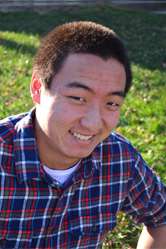Major: Chemical Engineering
“EEM Characterization of Surface Waters Along a Rural-to-Urban Gradient in Baltimore”

Dissolved organic matter (DOM) is a broad category of compounds that contains thousands of complex molecules, including materials formed from the decay of plant and animal matter and organic molecules discharged from wastewater treatment plants. DOM is present in every water source and may be an indicator of land use inputs to surface water. Recently, fluorescence spectroscopy has been used to qualitatively measure and characterize DOM from wastewater, water basins, and lake water, among others. This technique allows samples to be quickly, reproducibly and inexpensively analyzed. We propose that fluorescence spectroscopy can be used to determine whether urban waters are compromised by leaking wastewater infrastructure. The hypothesis of this project is that the natural DOM matrix of streams differs from that of raw wastewater. By recording the fluorescence excitation-emission matrices (EEMs) for these waters, the associated signature may indicate the presence of raw wastewater in streams. Surface waters samples were collected from nine sites along a rural-to-urban gradient in Baltimore, Maryland; wastewater samples were collected from an anonymous wastewater treatment plant near Baltimore. EEMs were generated for the surface water and wastewater samples. Analysis of the EEMs indicated that raw wastewater may be leaking into Gwynns Run, which discharges to Gwynns Falls in Southwest Baltimore City. Additionally, the wastewater signature was not observed in more rural streams like the Gwynns Falls at Glyndon (Baltimore County). Ratios of the fluorescence signal at select wavelengths were used to quantitatively describe the DOM matrix along the rural-to-urban gradient. Additionally, inner filter corrections were implemented to adjust the generated data for fluctuations in the fluorescence of the samples. These results indicated that trends in land use (i.e., more rural vs. more urban) are correlated to the fluorescence signature. Upon further validation, we propose using EEMs to detect leaking wastewater infrastructure in urban settings.
This research was supported in part by a grant to UMBC from the Howard Hughes Medical Institute through the Precollege and Undergraduate Science Education Program, an Undergraduate Research Award from the UMBC Office of Undergraduate Education and the MARC U*STAR Program at UMBC through the National Institute of General Medical Sciences. The authors also acknowledge Mr. Dan Dillon and Dr. Stuart Schwartz for sample collection.
How did you find your mentor for your research, scholarship, or artistic project?
I met my mentor, Dr. Lee Blaney, by spending time near the Chemical Engineering department’s faculty offices.
How did you know this was the type of research you wanted to do?
In the future, I plan to obtain a PhD in Environmental Engineering; therefore, I wanted to get research experience before entering graduate school. After receiving advice from my peers, mentors, and members of my would-be mentor’s lab, I formally asked Dr. Blaney if I could join his lab.
What is the focus of your research?
My research focus is on characterizing various water and wastewater samples by recording the fluorescence excitation-emission matrices (EEMs) for these waters.
Do you get course credit for this work?
Not this semester, but I am planning to do an independent study in the spring 2015 semester.
How much time do you put into it?
I work 10-15 hours per week during the academic year.
What has been the hardest part about your research?
The most difficult aspect of my research has been learning to independently plan my experiments and analyze my data. I have relished this opportunity to take the lead on my project and learn (and teach) new techniques to other lab members.
How does your research relate to your work in other classes?
My research draws from many of my classes, including introductory chemistry classes and 300-level Environmental Engineering classes. More specifically, my work focuses on water treatment and dissolved organic matter. For that reason, my environmental chemistry and organic chemistry classes have been especially useful.
Is this your first research project?
Actually, this project is my second research experience. I started doing research for Dr. Mark Marten in Fall 2012, where my focus was on analyzing and improving industrially-relevant protein secretions of the model fungus Aspergillus nidulans through random mutagenesis.
How did you hear about the Undergraduate Research Award (URA) program?
When I was working for Dr. Marten, he had a student working for him who had won this award multiple times. Dr. Marten let me know when the application was open and I applied for the award in 2013 and 2014.
What academic background did you have before you applied for the URA?
When I first applied for the URA, I was midway through my sophomore year. Hence, I had taken the introductory chemistry classes, as well as organic chemistry and one chemical engineering course.
Was the application difficult to do?
The application is certainly extensive and required a thorough knowledge of the research project, as well as the motivation for the proposed work. However, with help from my mentor, the application process enabled me to understand my project more completely.
How did your mentor help you with the application?
My mentor was especially helpful in editing my application, as he provided an experienced set of eyes to review my writing.
What else are you involved in on campus?
I am the President of the UMBC chapter of the American Institute of Chemical Engineers (AIChE), President of the Honors College Council, and a tutor for the Chemistry Tutorial Center.
What is your advice to other students about getting involved in research?
Start early! I started research when I was a sophomore, but I wish I started much sooner!
7/21/2024